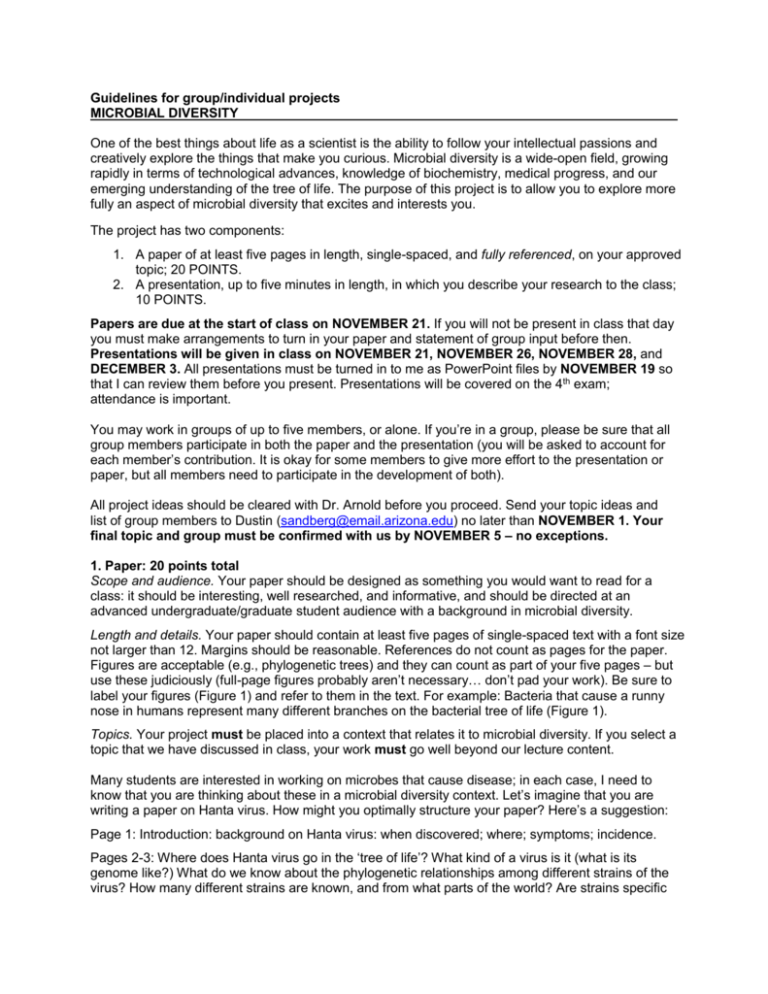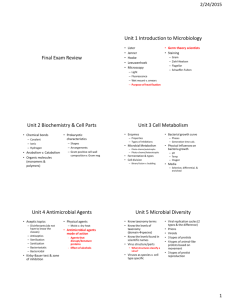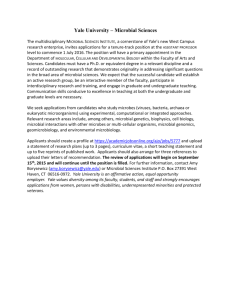Guidelines for group/individual projects
advertisement

Guidelines for group/individual projects MICROBIAL DIVERSITY One of the best things about life as a scientist is the ability to follow your intellectual passions and creatively explore the things that make you curious. Microbial diversity is a wide-open field, growing rapidly in terms of technological advances, knowledge of biochemistry, medical progress, and our emerging understanding of the tree of life. The purpose of this project is to allow you to explore more fully an aspect of microbial diversity that excites and interests you. The project has two components: 1. A paper of at least five pages in length, single-spaced, and fully referenced, on your approved topic; 20 POINTS. 2. A presentation, up to five minutes in length, in which you describe your research to the class; 10 POINTS. Papers are due at the start of class on NOVEMBER 21. If you will not be present in class that day you must make arrangements to turn in your paper and statement of group input before then. Presentations will be given in class on NOVEMBER 21, NOVEMBER 26, NOVEMBER 28, and DECEMBER 3. All presentations must be turned in to me as PowerPoint files by NOVEMBER 19 so that I can review them before you present. Presentations will be covered on the 4th exam; attendance is important. You may work in groups of up to five members, or alone. If you’re in a group, please be sure that all group members participate in both the paper and the presentation (you will be asked to account for each member’s contribution. It is okay for some members to give more effort to the presentation or paper, but all members need to participate in the development of both). All project ideas should be cleared with Dr. Arnold before you proceed. Send your topic ideas and list of group members to Dustin (sandberg@email.arizona.edu) no later than NOVEMBER 1. Your final topic and group must be confirmed with us by NOVEMBER 5 – no exceptions. 1. Paper: 20 points total Scope and audience. Your paper should be designed as something you would want to read for a class: it should be interesting, well researched, and informative, and should be directed at an advanced undergraduate/graduate student audience with a background in microbial diversity. Length and details. Your paper should contain at least five pages of single-spaced text with a font size not larger than 12. Margins should be reasonable. References do not count as pages for the paper. Figures are acceptable (e.g., phylogenetic trees) and they can count as part of your five pages – but use these judiciously (full-page figures probably aren’t necessary… don’t pad your work). Be sure to label your figures (Figure 1) and refer to them in the text. For example: Bacteria that cause a runny nose in humans represent many different branches on the bacterial tree of life (Figure 1). Topics. Your project must be placed into a context that relates it to microbial diversity. If you select a topic that we have discussed in class, your work must go well beyond our lecture content. Many students are interested in working on microbes that cause disease; in each case, I need to know that you are thinking about these in a microbial diversity context. Let’s imagine that you are writing a paper on Hanta virus. How might you optimally structure your paper? Here’s a suggestion: Page 1: Introduction: background on Hanta virus: when discovered; where; symptoms; incidence. Pages 2-3: Where does Hanta virus go in the ‘tree of life’? What kind of a virus is it (what is its genome like?) What do we know about the phylogenetic relationships among different strains of the virus? How many different strains are known, and from what parts of the world? Are strains specific to different regions of the world? Has the virus co-evolved with its host, and what is the evidence for this? What are some other viruses that have a similar genomic structure (how many strands/RNA vs. DNA/etc.), and what family contains the Hanta virus? Pages 4-5: Here, you can be flexible: what are the prospects for treatment and control? Is there a vaccine? Why is this an emerging disease? What environmental factors are important in its virulence? How can this virus influence our understanding of other important viruses? Interesting How can the topics we discussed in this class be applied in the study of the pathogen or its effects? These are guidelines for ideas to help you expand your topic into a microbial diversity context. References. I expect that your paper will contain at least ten references. Your references must include at least four papers from the primary literature. By ‘primary literature’ I am referring to scientific papers, authored by scientists, and published in scientific journals. Magazines such as Discover or Scientific American do NOT count as primary literature (but they can be used as other references). You may cite reliable web pages, but for no more than two of your references. Citations should be included in the text in standard scientific format. Here’s an excerpt from one of my recent papers showing that format (author and date): “Data from the nuclear ribosomal large subunit have been used in over 150 phylogenetic analyses for fungi (Lutzoni et al. 2004). Although individual loci provide only limited utility in reconstructing deep nodes (e.g., Liu and Hall 2004), numerous tools exist …” Papers are then listed in the ‘References’ or ‘Literature Cited’ at the end of your paper: Liu YJ, Hall BD. 2004. Body plan evolution of ascomycetes, as inferred from an RNA polymerase II subunit. Molecular Biology and Evolution 16:1799–1808. Content. I expect you to adhere to high standards of professionalism in preparing your paper. Cite your references! I know that I don’t need to remind you, as you’re all honest and bright and creative – but I have to say it: there will be no tolerance of plagiarism. Your grade will be broken down as follows: Quality of research, organization and writing Microbial diversity context (ties to topics discussed in class) At least ten citations; no more than two from internet sources Citation of at least four papers from the primary literature Spelling, grammar, completeness 8 points 5 points 3 points 2 points 2 points 2. Presentation (10 points total) The presentation will be based on your research for your paper. You have two options: you may present a Powerpoint-style, computer-based lecture; or your may present a poster. You will have up to 5 minutes to present your group or individual project. Plan on presenting for at least 4 minutes: I’d rather see 4 minutes of good work than 5 minutes of filler. Your objective is to teach the class something about what you learned. Expand our minds! You are the expert! And recognize that you have very little time to get your point across. What do you want us to learn? In preparing your poster or slide show, use fonts wisely. Make sure that we can see the text! I’m more interested in content than in glitter glue, fancy animations, funky backgrounds and fancy fonts. You can use your judgment, but I’d prefer professional formats. It is acceptable to use images from the Internet, but you must cite their origin (on a slide or at the bottom of your poster). Your grade will be broken down as follows: Quality of visual aids Quality of presentation (conveyance of information) 2.5 points 7.5 points





